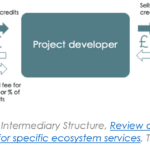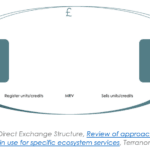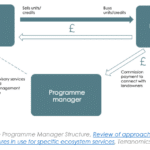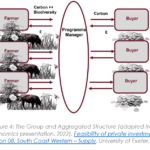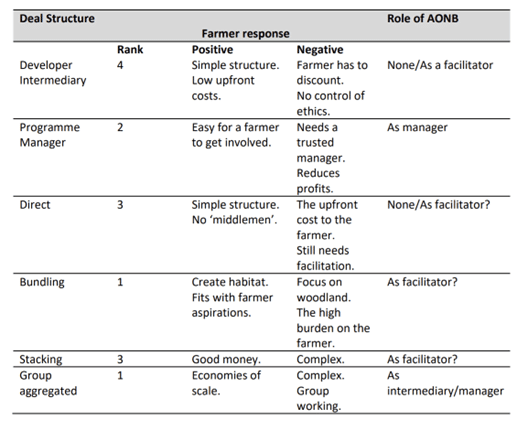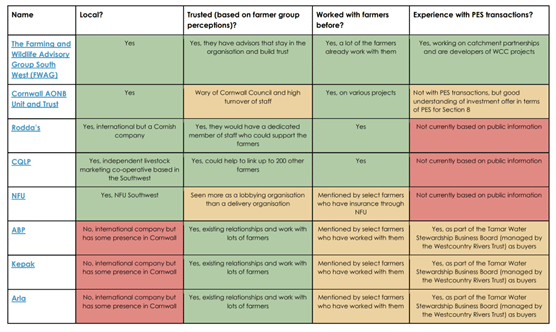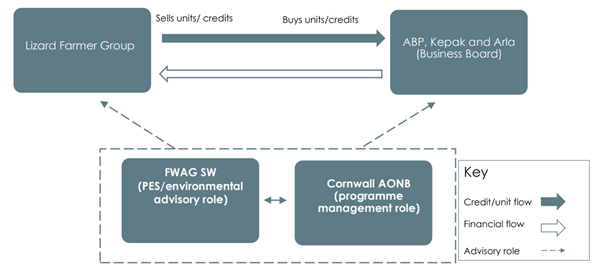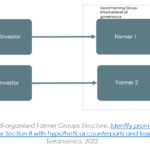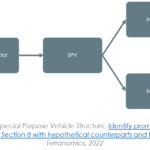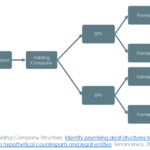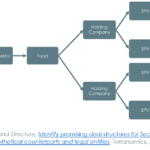Project Summary
The Cornwall AONB Partnership aims to channel private finance into nature across Section 08 of the Cornwall Area of Outstanding Natural Beauty (AONB), which is one of 12 sections of the AONB that cover 958 square kilometres. The project team – Cornwall AONB, University of Exeter, Gain Consulting and Terranomics – has been exploring both the ‘supply-side’ and the governance model of the project.
The project has not yet committed to a governance model under which it will operate. However, it has undertaken research on deal structures, legal entities and trusted intermediaries, working with its farmer group. Full detail of the project can be found on its website, published by Cornwall AONB.
Acknowledgments
With many thanks to the following individuals for their time and insight:
Melodie Manners, Business Development Officer, Cornwall Area of Outstanding Natural Beauty
Collette Beckham, Director, Gain Consulting
Dr Grace Twiston-Davies, Research Fellow, Environment and Sustainability Institute, University of Exeter
Chris Knight, Director and Co-Founder, Terranomics
Tom Chellew, Senior Associate, Terranomics
Date published: 17/02/2023
Deal structures and organisational governance
As part of its work with the Lizard farmer group (see Milestone 2), the project team explored potential deal structures by which these farmers could receive payments for changes in land use.
Chris Knight and Tom Chellew of Terranomics, prepared a set of high-level deal models and the project team presented these to the Lizard farmer group during its workshop in August 2022, during which the team recorded direct feedback on the feasibility of these structures attracting the ‘supply side’ of an ecosystem services deal
The models provide a range of ways to structure deals between sellers and buyers. Although the structures below show ‘carbon’ as the primary ecosystem service, these could potentially work for other units or credits.
Dr Grace Twiston-Davies of the University of Exeter subsequently wrote a report that set out the full detail of these different structures and the subsequent farmer feedback. The four structures explored were:
- Developer Intermediary
- Direct Exchange
- Programme Manager
- Group and Aggregated Structure
(Click to expand)
Overall, the workshop allowed the project team to establish the key principles that farmers wanted embedded in the organisational structure of the project. Namely:
- Farmers want some control and say over who buys their credits or units
- There should be flexibility on entering and exiting the structures if / when new schemes emerge
- The deal structure, its potential benefits and governance arrangements need to be transparent and simple to understand.
After this discussion, the farmers were asked to rank the types of deal structures that most appealed to them. This showed that the farmers were most interested in operating via a programme manager, and taking a group / aggregated approach, acknowledging that a certain intermediary role could be valuable for making the deal simpler and more manageable for farmers.
Table 1: Overview of farmer feedback on the potential deal structures and the role of Cornwall AONB, Feasibility of private investment in Section 08, South Coast Western – Supply, University of Exeter, 2022
Building on this feedback, the project team then explored potential counterparts who could act as a facilitator or intermediary, as well as types of legal entities to facilitate these deal structures.
Trusted intermediaries and counterparts
Several counterparts that could act as programme manager were identified by the farmer group and project team during workshops. The findings from this workshop are set out in a report written by Terranomics. A summary of these findings is as follows:
It was established that the programme manager would help with marketing, the negotiation of agreements with buyers, carrying out the transaction directly with the buyer on behalf of the farmers, and building a pipeline for future trades. This would be for a fixed fee or percentage based commission of the credits/units. In essence, they would manage the overall transaction.
In terms of eligibility, the farmer group felt it is important for the organisation to:
- be local to Section 08 of the Cornwall AONB,
- have a level of trust with farmers, and
- have had some level of engagement with farmers before,
The farmers also expressed a desire for the organisation to have experience of designing a suite of environmental interventions and negotiating agreements with buyers, and stability in terms of staff turnover, resources and restructuring (to enable a smoother and efficient farmer-advisor relationship)
Some of the identified counterparts that could play the role of programme manager, or other roles in the deal structure, are outlined in the table below. (To note, these are potential counterparts and were not engaged through this NEIRF project).
Table 2: Identified counterparts based on farmer feedback, Identify promising deal structures for Section 8 with hypothetical counterparts and legal entities, Terranomics, 2022
FWAG SW appeared to be a possible candidate to act as a programme manager. FWAG is a registered charity representing the South West region’s farmers and landowners in the delivery of wildlife conservation. It has already carried out considerable work in building relationships with farmers and landowners/managers on the Lizard, and also has experience with Payments for Ecosystem Services (PES). As FWAG SW is specialist advisor organisation for farmers, the project team believes it would be able to give useful advice.
The Cornwall AONB Trust was also considered a candidate, but the farmer group wanted an understanding of exactly what the AONB Trust does and the links it has with Cornwall Council. The project team considered that the Cornwall AONB Trust could play more of a coordination role in the deal structure between the farmers, FWAG and buyers.
ABP Food Group, Kepak, and Arla are all food production companies that have experience of PES transactions through a fund structure, such as the Channel Payments for Ecosystem Services (CPES). The project team and the farmer group agreed that this level of expertise could be useful on the project’s ‘buy side’ by working through the programme manager. The project team discussed the creation of a similar business board as the CPES Fund, to have different representation of stakeholders involved.
Rodda’s, the NFU and CQLP are organisations that could help Section 08 reach a larger scale and link up with other farmers. However, they do not have any experience in PES structures, based on the information available to the project team. Nevertheless, it was considered that they could be important promoters and help to recruit more farmers.
Figure 5: Programme Manager Generic Deal Structure, Identify promising deal structures for Section 8 with hypothetical counterparts and legal entities, Terranomics, 2022
Legal entity structures
Once feedback was taken from the farmer group on potential deal structures and intermediaries, the project team then analysed legal entity types. “Choosing the right legal structure is one of the final steps in becoming ‘investor ready’. It is not essential to have all the details finalised at this stage but having a good idea of what legal structures to consider puts the project in good stead” comments Knight.
Based on feedback from the previous workshops with the Lizard Farmer group, the project team understood that the ideal legal structure would need to:
- incorporate multiple stakeholders
- be flexible allowing farmers to come in and out
- take in private investment
- have a transparent process
- he a simple structure
- pay out to different farmers based on level of involvement
The project team then discussed the different legal entity types and governance structures that may be suited to the project. These were not formally discussed with the farmer group due to the early stage of the project’s development. However the project team analysed these in relation to the above points, as outlined in a report written by Terranomics.
Each type of governance structure and the project team’s considerations are as follows:
- Self Organised Farmer Group
- Special Purpose Vehicle
- Holding Company
- Fund Structure
(Click to expand)
Ultimately, the project team recommended that a more informal legal structure, such as a self-organised farmer group or a CIC seems best aligned for Section 8 and both have been used in similar projects in the UK. The CIC could be facilitated by the programme manager, and it has proven a successful model for other PES deal structures in the UK of a similar size, such as the Wyre Catchment Natural Flood Management Project. If there are ambitions to scale the project up across the Cornwall AONB, a fund or holding company might be more applicable.
Conclusions
Based off of feedback gathered across all workshops and other engagements with the farmer group, the project team identified a set of principles for governing and supporting the ‘supply side’ of the Cornwall AONB project. These findings are taken directly from a report authored by Dr Twiston-Davies of the University of Exeter in 2022.
According to the team’s findings, the project’s governance would be best conducted:
- Through a Programme Manager or Group and Aggregated structure
Feedback from the farmer group indicated that the Programme Manager and Group and Aggregated structures were the most accepted structures.
- Through a trusted Programme Manager
It was clear from the farmer group that trust in a Programme Manager is essential. To maintain and enhance trust as a potential Programme manager, Cornwall AONB will need to continue to build a positive profile in the farming sector.
- Ethically
Farmers want control over who buys their credits or at least be confident that the ethics behind the transactions align with their values – they do not want to be helping to ‘greenwash’ businesses that have bad environmental practices. This indicates that Cornwall AONB may need to create criteria to define what sorts of businesses they want to engage on the demand side.
- Securely but flexibly
The biggest risk to the supply side of private finance in Cornwall AONB is the uncertainty of public finances, specifically ELMs. This indicates that if Cornwall AONB may need to consider having transferability to other schemes or break clauses (e.g. 5 years similar to the current Higher-tier Countryside Stewardship) to encourage farmers to sign up.
- Simply
It was made clear by the group that simplicity is key. However, the most simple deal structure i.e. the Direct structure was not appealing to the group for other reasons. This indicates that Cornwall AONB may need a substantial budget for a communications strategy and resources like infographics, leaflets, and videos that translate what could be a complicated structure to something clear and simple for farmers.
- Compatibly
Compatibility with a food and farming-focused business but also with the farmer group’s aspirations for nature and their shared goals as part of the Landscape Recovery Framework is key. For more widespread uptake, the use of private finance would also need to be compatible with productive farming and the Net-Zero requirements of farm businesses.
- Collaboratively
The group see benefits in collaboration and the Group and Aggregated structure, but raised concerns about competition, risk and the reduction in value for the individual. Clear governance and agreed codes of conduct for those involved as sellers would be essential.
- Through Pilots
As the farmer group is reluctant to enter into any deals in the next 1-3 years, or be pioneers for private investment deals, pilot projects could be the next steps ideally, focusing on Net-Zero and Nature-Positive requirements.
For next steps of the project, see the Cornwall AONB Milestone 2 case study.
Sources:
- Interview with project team, 2023
- Cornwall AONB NEIRF project website, including:
- Full NEIRF project report
- Appendix 4: Identify promising deal structures for Section 8 with hypothetical counterparts and legal entities
- Appendix 9: Review of approaches and deal structures in use for specific ecosystem services
- Appendix 10: Feasibility of private investment in Section 08, South Coast Western – Supply



